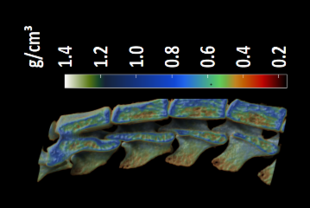Researchers from Helmholtz Zentrum München, together with the International Mouse Phenotyping Consortium (IMPC), have uncovered a large number of novel genes controlling the mineral density of bone. Because bone mineral density (BMD) is low in patients with osteoporosis, these findings help to better understand the underlying molecular mechanisms of the disease. The new insight is important to advance precision medicine for people affected by osteoporosis in terms of prevention and therapeutic options. The study was recently published in PLoS Genetics.
Osteoporosis is a common disease, characterized by decreased BMD and increased fracture risk, which causes a profound health burden world-wide. Genes are known to control the onset and progression of bone diseases such as osteoporosis.
In this study pre-clinical work at the German Mouse Clinic, Institute of Experimental Genetics of the Helmholtz Zentrum München, and IMPC systematically probed more than 1000 genes for their potential effect on BMD. The skeletal phenotyping was performed using Dual Energy X-Ray Absorptiometry (DXA), the gold standard technique employed also in the clinic for diagnosis of osteoporosis. A total of 200 genes were found to significantly affect BMD. This pool of BMD genes comprised 141 genes with previously unknown functions in bone biology. Examination of these BMD genes in osteoclasts and osteoblasts underscored BMD pathways, including vesicle transport, in these cells and together with in silico bone turnover studies resulted in the prioritization of candidate genes for further investigation.
In close cooperation with medical scientists and epidemiologists this study adds fundamental knowledge to recent human studies, such as the 'Genome-Wide Association Study' (GWAS) data based on the UK biobank and the data set of the 'Genetic Factors for Osteoporosis Consortium' (GEFOS). The discovery and study of novel BMD genes will help to better understand the causes and therapeutic options for patients with low BMD.
Swan AL, Schütt C, Rozman J, Del Mar Muñiz Moreno M, Brandmaier S, Simon M, Leuchtenberger S, Griffiths M, Brommage R, Keskivali-Bond P, Grallert H, Werner T, Teperino R, Becker L, Miller G, Moshiri A, Seavitt JR, Cissell DD, Meehan TF, Acar EF, Lelliott CJ, Flenniken AM, Champy MF, Sorg T, Ayadi A, Braun RE, Cater H, Dickinson ME, Flicek P, Gallegos J, Ghirardello EJ, Heaney JD, Jacquot S, Lally C, Logan JG, Teboul L, Mason J, Spielmann N, McKerlie C, Murray SA, Nutter LMJ, Odfalk KF, Parkinson H, Prochazka J, Reynolds CL, Selloum M, Spoutil F, Svenson KL, Vales TS, Wells SE, White JK, Sedlacek R, Wurst W, Lloyd KKC, Croucher PI, Fuchs H, Williams GR, Bassett JHD, Gailus-Durner V, Herault Y, Mallon AM, Brown SDM, Mayer-Kuckuk P, Hrabe de Angelis M; IMPC Consortium. Mouse mutant phenotyping at scale reveals novel genes controlling bone mineral density. PLoS Genet. 2020 Dec 28;16(12):e1009190. doi: 10.1371/journal.pgen.1009190. Epub ahead of print. PMID: 33370286.


